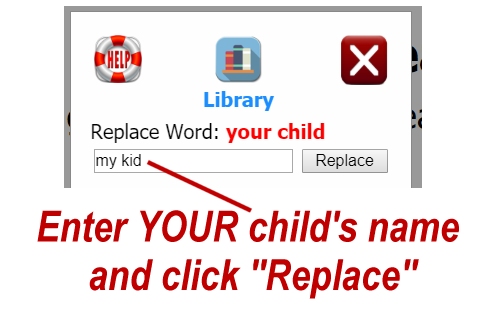 Training Wheels for Learning to Read – Parent Version.
Training Wheels for Learning to Read – Parent Version.
(for parents of children in preschool through 3rd grade)
 First-Personalizing | Training Wheels Idea | Component Overview
First-Personalizing | Training Wheels Idea | Component Overview
 Modeling Reading | LetterBlocks | LetterScope | WordWall | WordFamilies | PQ Games | WordScope
Modeling Reading | LetterBlocks | LetterScope | WordWall | WordFamilies | PQ Games | WordScope

 First-Personalizing – Please take a moment to personalize this page (and in the process learn to personalize the Magic Ladder for yourchild). Click on the help and settings button in the top right corner of this page. When it opens, type yourchild’s name into the “Replace Word” area. If you were successful you should now see your child’s name here (yourchild) and throughout this page.
First-Personalizing – Please take a moment to personalize this page (and in the process learn to personalize the Magic Ladder for yourchild). Click on the help and settings button in the top right corner of this page. When it opens, type yourchild’s name into the “Replace Word” area. If you were successful you should now see your child’s name here (yourchild) and throughout this page.
 Training Wheels on bicycles help beginning bike riders by reducing the complexity, difficulty, and scariness of learning to pedal their bikes without losing balance – without falling. As they reduce the complexity and difficulty of coordinating the movements involved, they also reduce the fear of falling. Physically, cognitively, and emotionally, they create a learning conducive structure – a ‘safer, easier, path for learning’. The purpose of this page is about you learning to use the components of the Magic Ladder to create a “training wheels -like” guidance and support system, that helps yourchild by reducing the complexity, difficulty, and fear involved in learning to read.
Training Wheels on bicycles help beginning bike riders by reducing the complexity, difficulty, and scariness of learning to pedal their bikes without losing balance – without falling. As they reduce the complexity and difficulty of coordinating the movements involved, they also reduce the fear of falling. Physically, cognitively, and emotionally, they create a learning conducive structure – a ‘safer, easier, path for learning’. The purpose of this page is about you learning to use the components of the Magic Ladder to create a “training wheels -like” guidance and support system, that helps yourchild by reducing the complexity, difficulty, and fear involved in learning to read.
The Magic Ladder Components:
Read the stories to your child stopping on red words, and all words that are new to your child, or that fascinate your child, or that you think would fascinate the child.
WordScope is a tool for exploring, playing with, and learning about how the letters in any chosen printed word participate in the sounds that are heard when the word is spoken. WordScope is tool for “blowing up” words and seeing and hearing how a word’s graphemes relate to its phonemes.
LetterScope is a tool for exploring, playing with, and learning about the relationships between letters and their numerous possible sounds. LetterScope is a tool for “blowing up” letters and hearing the various sounds they can express. Learning to not reflexively experience letters by their letter names or common sounds is critical to progress in decoding.
When you stop on a word use the pop-up, modelling the behavior of click and try to read again (try to sound the word out using the PQs provided), click and try to read again (try to sound the word out using the PQs provided). Sometimes model recognizing the word before the system sounds it out, sometimes letting the system sound it out.




















